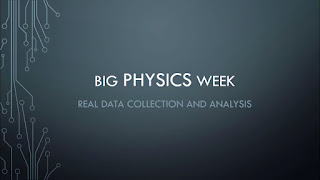The last week of term before Easter we declared Big Physics Week for S3 pupils. The best data logging equipment was made available to our researchers so that they could investigate in depth a topic of their choice. Two of the projects involved the use of Vertigo; mountain biking down the school's track and parkour.
Software issues meant that data processing had to be done on a spreadsheet. This gave the pupils an instant appreciation of just how much data they had collected. The pupils looked at the raw data GPS, accelerations and gyro. From this they created graphs.
The pupils wanted to show distance and velocity graphs. I had to do the conversion of lat, long and height into distance from the start. I am happy with the distance v time graph.
From the distance conversions I calculated speed. The speed graph was very messy.
I used some conditional damping on the speed data to try to smooth out the graph.
After the holiday it will be good to see what the pupils can do with all this new data.
























